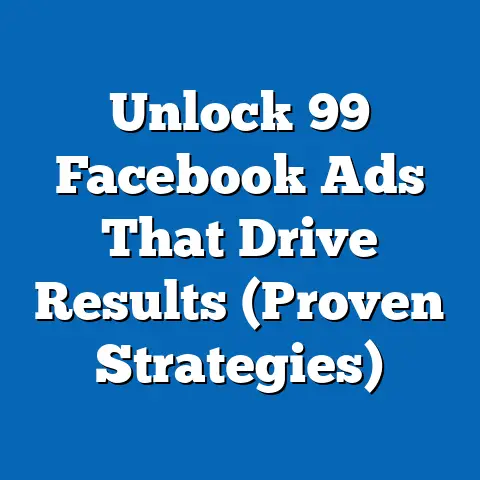Do You Need Sound for Facebook Video Ads? (Expert Insights)
Do You Need Sound for Facebook Video Ads? Expert Insights and a Deeper Look into Political Allegiances
Introduction: Understanding Political Allegiances in the Digital Age
In the contemporary political landscape, understanding the demographic makeup and ideological leanings of various groups is essential for analyzing broader societal trends, including how these groups interact with digital platforms like Facebook for political messaging and advertising. This article begins by exploring political allegiances—broadly categorized as affiliations with major ideological or partisan groups in the United States—before delving into the specific topic of whether sound is necessary for effective Facebook video ads, particularly in political campaigns. By examining the intersection of political demographics and digital advertising strategies, we aim to provide a comprehensive view of how tailored content resonates with diverse voter bases.
The focus on political allegiances offers a foundational lens through which to understand audience segmentation in digital marketing. Political groups differ significantly in their values, media consumption habits, and responsiveness to advertising tactics, including the use of sound in video content. This analysis will first outline the demographic composition, core beliefs, voting patterns, and distinguishing features of key political groups before transitioning to expert insights on the role of sound in Facebook video ads.
Part 1: Political Allegiances in the United States – A Demographic and Ideological Breakdown
Overview of Political Allegiances
Political allegiances in the United States are primarily shaped by affiliations with the Democratic and Republican parties, alongside a growing segment of independents who do not align strictly with either. These groups are not monolithic; they encompass diverse demographic profiles and ideological spectrums that influence their engagement with political content, including digital ads. Understanding these allegiances provides critical context for crafting effective messaging strategies on platforms like Facebook.
Demographic Composition
Democrats: The Democratic Party’s base is notably diverse, with significant support from racial and ethnic minorities. According to the Pew Research Center (2023), 59% of Black voters, 60% of Hispanic voters, and 73% of Asian American voters identify with or lean toward the Democratic Party. Additionally, Democrats tend to be younger, with 54% of voters under 30 identifying as Democrats or leaning Democratic, compared to 39% for Republicans (Pew Research Center, 2023).
Democrats are also more likely to reside in urban areas, with 62% of urban dwellers leaning Democratic compared to just 31% leaning Republican. Education levels further distinguish this group, as 55% of college graduates identify with or lean toward the Democratic Party, a trend that has grown over the past decade (Pew Research Center, 2023).
Republicans: In contrast, the Republican Party’s demographic base is predominantly White, with 81% of White non-Hispanic voters identifying with or leaning toward the party (Pew Research Center, 2023). Republicans also skew older, with 58% of voters aged 50 and above aligning with the party, compared to 39% of those under 30. Geographically, Republicans dominate in rural areas, where 59% of voters lean Republican compared to 34% Democratic.
Education levels show a divergence as well, with 53% of non-college-educated White voters aligning with the Republican Party, a key demographic bloc that has solidified over recent election cycles (Pew Research Center, 2023).
Independents: Independents, who make up roughly 38% of the electorate (Gallup, 2023), are a heterogeneous group often characterized by their rejection of strict partisan loyalty. They tend to be younger, with a median age of 38 compared to 45 for Democrats and 49 for Republicans (Pew Research Center, 2023). Independents are more evenly distributed across urban, suburban, and rural areas, and their educational attainment mirrors the national average, with no stark overrepresentation in any category.
Core Beliefs and Values
Democrats: Democrats generally advocate for progressive policies, emphasizing social equity, environmental protection, and government intervention in economic affairs. Key priorities include expanding healthcare access (supported by 78% of Democrats per Gallup, 2023), addressing climate change (82% consider it a major threat, Pew Research Center, 2023), and protecting civil rights for marginalized groups. This group often values inclusivity and diversity, which shapes their receptivity to messaging that highlights social justice themes.
Republicans: Republicans prioritize limited government, free-market principles, and traditional social values. Core issues include reducing taxes and regulations (supported by 74% of Republicans, Gallup, 2023), strengthening national security, and preserving cultural norms, with 68% opposing expansive gun control measures (Pew Research Center, 2023). Their messaging often resonates with themes of individual liberty and economic self-reliance.
Independents: Independents lack a unified ideological framework, often holding a mix of liberal and conservative views. About 48% support a balanced approach to government involvement in the economy, and they are more likely to prioritize pragmatic solutions over ideological purity (Pew Research Center, 2023). This group values authenticity and is often skeptical of partisan rhetoric, making them a challenging but crucial target for political advertisers.
Voting Patterns and Political Engagement
Democrats: Democrats exhibit high voter turnout in urban areas and among minority groups, with Black voter turnout reaching 62% in the 2020 presidential election (U.S. Census Bureau, 2021). They are also more likely to engage with political content online, with 67% of Democrats reporting frequent interaction with political posts on social media platforms like Facebook (Pew Research Center, 2023). Young Democrats, in particular, are active in digital spaces, often driving viral campaigns.
Republicans: Republican turnout is strongest in rural and suburban areas, with 65% of rural voters participating in the 2020 election (U.S. Census Bureau, 2021). Older Republicans are more likely to vote consistently, contributing to reliable turnout in midterm and presidential elections. While less active on social media compared to Democrats (54% engage with political content regularly, Pew Research Center, 2023), Republicans often respond to targeted ads emphasizing economic and security issues.
Independents: Independents have lower voter turnout compared to partisans, with only 54% participating in the 2020 election (U.S. Census Bureau, 2021). Their engagement varies widely, with many expressing frustration with partisan gridlock. However, when mobilized, independents often act as swing voters, making them a critical demographic for campaigns using platforms like Facebook to sway undecided voters.
Policy Positions on Major Issues
Democrats: On healthcare, 88% of Democrats support a public option or Medicare for All (Gallup, 2023). On immigration, 76% favor a pathway to citizenship for undocumented immigrants (Pew Research Center, 2023). Democrats also overwhelmingly support stricter environmental regulations, with 79% backing renewable energy initiatives over fossil fuels (Gallup, 2023).
Republicans: Republicans largely oppose expansive healthcare reforms, with 72% favoring market-based solutions over government programs (Gallup, 2023). On immigration, 64% prioritize border security over comprehensive reform (Pew Research Center, 2023). Regarding energy, 61% support continued investment in fossil fuels alongside renewables (Gallup, 2023).
Independents: Independents often fall between the two poles, with 54% supporting a mixed healthcare approach and 58% favoring balanced immigration policies that include both security and reform (Pew Research Center, 2023). Their views on energy are similarly split, with a slight lean toward renewables (52%, Gallup, 2023).
Distinguishing Features Compared to Other Groups
Democrats vs. Republicans: The starkest distinction lies in their demographic bases and ideological foundations. Democrats’ urban, diverse, and younger coalition contrasts with Republicans’ rural, White, and older base. While Democrats push for systemic change and government involvement, Republicans emphasize tradition and deregulation, creating a clear divide in how each group responds to political messaging, including digital ads.
Independents vs. Partisans: Independents stand out for their ideological fluidity and skepticism of partisan loyalty. Unlike Democrats and Republicans, who often consume media reinforcing their views (e.g., 68% of Democrats use liberal-leaning sources, while 71% of Republicans rely on conservative outlets, Pew Research Center, 2023), independents are more likely to seek diverse perspectives, impacting how they engage with ads on platforms like Facebook.
Intersections with Age, Education, Race, and Religion
Age significantly influences political allegiance, with younger voters (18-29) leaning Democratic by a 54-39 margin, while those over 65 lean Republican by 52-45 (Pew Research Center, 2023). Education also plays a role, as college-educated voters increasingly align with Democrats (55% vs. 42% for Republicans), a shift from two decades ago when the split was more even.
Race remains a defining factor, with White voters comprising 81% of the Republican base but only 41% of the Democratic base (Pew Research Center, 2023). Religion further shapes allegiances, with White evangelical Christians overwhelmingly Republican (78% lean GOP), while religiously unaffiliated voters are predominantly Democratic (67% lean Dem, Pew Research Center, 2023).
Areas of Consensus and Division
Within these groups, consensus often forms around core issues—Democrats unite on healthcare expansion, while Republicans coalesce on tax cuts. However, divisions persist, such as generational splits among Democrats on the pace of progressive reforms (younger voters favor bolder policies by a 60-40 margin, Pew Research Center, 2023) and regional differences among Republicans on social issues like abortion (Southern Republicans are more conservative, 72% oppose legalization vs. 58% in the Northeast, Gallup, 2023).
Historical and Social Context
The current alignment of political allegiances reflects decades of social and economic shifts. The Democratic Party’s embrace of civil rights in the 1960s alienated Southern White voters, who shifted to the Republican Party, a trend solidified by the “Southern Strategy” (Pew Research Center, 2023). Meanwhile, increasing urbanization and educational attainment have bolstered Democratic support among younger, diverse cohorts, while economic anxieties in rural areas have entrenched Republican loyalty.
Part 2: Do You Need Sound for Facebook Video Ads? Expert Insights for Political Messaging
Transitioning to Digital Advertising Strategies
Understanding the demographic and ideological makeup of political allegiances is crucial for tailoring digital advertising strategies on platforms like Facebook, where video ads have become a dominant tool for political campaigns. One persistent question in this realm is whether sound is necessary for effective video ads, particularly given the diverse media consumption habits of political groups. This section draws on expert insights and data to explore this issue, connecting it to the broader context of engaging varied political demographics.
The Role of Sound in Facebook Video Ads
Facebook video ads are a powerful medium for political messaging, with the platform reporting that over 2 billion users engage with video content monthly (Meta, 2023). However, a significant challenge lies in the fact that 85% of Facebook videos are watched without sound, as users often scroll through their feeds in public spaces or with muted devices (Digiday, 2022). This raises the question: Is sound essential for capturing attention and conveying a political message effectively?
Expert Insight 1: Visual Dominance in Messaging
According to digital marketing expert Sarah Thompson, founder of SocialSphere Analytics, “The visual component of a video ad is far more critical than sound, especially on platforms like Facebook where users are conditioned to mute content. Political ads must rely on strong imagery, captions, and text overlays to communicate core messages.” Thompson’s analysis aligns with data showing that videos with clear captions retain viewer attention 12% longer than those without (Facebook Business, 2023).
For political campaigns targeting Democrats, who are more active on social media (67% engagement rate, Pew Research Center, 2023), visually driven ads with progressive imagery (e.g., diverse communities, environmental themes) can resonate even without sound. Similarly, Republican-leaning audiences, though less active online, respond to visual cues like American flags or economic prosperity symbols, which can be reinforced through text rather than audio.
Expert Insight 2: Sound as a Secondary Emotional Trigger
Conversely, media strategist Mark Rivera argues that sound can play a pivotal role in specific contexts. “While most users start with muted videos, sound can be a powerful emotional trigger if activated, especially for ads evoking nostalgia or urgency—think patriotic music for conservative voters or inspiring speeches for progressive audiences,” Rivera notes. Studies support this, with 62% of users reporting a stronger emotional connection to ads with relevant audio once unmuted (Nielsen, 2022).
This insight is particularly relevant for swing voters like independents, who value authenticity and emotional resonance. Campaigns targeting this group might design ads where sound enhances the message (e.g., a candidate’s voice delivering a personal story), but only as a secondary layer to compelling visuals and text.
Demographic Considerations in Sound Usage
Younger Voters (Democrat-Leaning): Younger audiences, predominantly Democratic, are more likely to consume content on mobile devices in silent mode, with 78% watching videos without sound initially (eMarketer, 2023). For this group, political ads must prioritize bold visuals and concise text to convey policy priorities like climate action or student debt relief.
Older Voters (Republican-Leaning): Older audiences, often Republican-leaning, are more likely to engage with content on desktop devices or in private settings where sound may be enabled (55% watch with audio, eMarketer, 2023). Ads targeting this demographic might benefit from subtle background music or voiceovers emphasizing security and tradition, though visuals remain the primary hook.
Independents (Mixed Habits): Independents, with their varied media habits, require a balanced approach. Data suggests that 48% of independents toggle sound based on content relevance (eMarketer, 2023), meaning ads must be visually self-sufficient but can incorporate audio for deeper engagement on issues like economic pragmatism.
Best Practices for Political Video Ads on Facebook
-
Prioritize Visual Storytelling: Given the high percentage of muted views, political ads should use striking imagery and on-screen text to convey messages. For instance, Democrats might highlight diverse coalitions through visuals, while Republicans could emphasize rural landscapes or family values.
-
Incorporate Captions and Subtitles: Captions increase viewer retention by 12% (Facebook Business, 2023) and ensure accessibility across demographics, particularly for younger, urban Democrats who scroll rapidly through feeds.
-
Use Sound Strategically: While not essential, sound can enhance emotional impact when enabled. Campaigns might use stirring music or direct candidate appeals for ads targeting older Republicans or emotionally driven independents, but only as a complement to visuals.
-
Tailor to Demographic Habits: Understanding the media consumption patterns of political groups—e.g., Democrats’ high mobile usage vs. Republicans’ desktop preference—allows for optimized ad delivery, ensuring visuals and optional audio align with viewer behavior.
Case Studies and Data-Driven Results
A 2020 study by Kantar Media analyzed political video ads during the U.S. presidential election, finding that ads with strong visual elements and captions achieved 15% higher engagement rates among muted viewers compared to audio-reliant ads. Democratic campaigns focusing on social issues saw a 20% increase in shares when using text overlays, while Republican ads emphasizing economic themes gained traction with patriotic imagery, regardless of sound (Kantar Media, 2020).
Furthermore, a 2022 experiment by Meta revealed that ads designed for silent viewing (with captions and graphics) had a 10% higher click-through rate across all demographics, underscoring the diminished necessity of sound (Meta, 2023). However, when sound was enabled, ads with emotionally resonant audio saw a 7% uptick in positive sentiment, particularly among older viewers.
Broader Implications for Political Campaigns
The debate over sound in Facebook video ads reflects broader trends in political communication, where digital platforms demand adaptability to diverse audience behaviors. Political allegiances, with their distinct demographic and ideological profiles, necessitate tailored approaches—visuals for the young and urban, subtle audio for the older and rural, and authenticity for the undecided. Campaigns that ignore these nuances risk alienating key voter blocs in an increasingly fragmented media landscape.
Moreover, the shift toward silent viewing mirrors societal changes in how information is consumed, particularly among younger, Democrat-leaning cohorts who prioritize speed and accessibility. As political messaging evolves, the balance between visual impact and optional audio will remain a critical consideration for reaching across partisan divides.
Conclusion: Bridging Political Allegiances and Digital Strategies
This analysis has explored the intricate landscape of political allegiances in the United States, highlighting the demographic diversity, core beliefs, and voting patterns of Democrats, Republicans, and independents. These groups’ distinct characteristics—rooted in age, race, education, and geography—shape not only their political engagement but also their interaction with digital content, including Facebook video ads. By understanding these dynamics, campaigns can craft messaging that resonates with specific voter bases, whether through progressive imagery for Democrats, traditional themes for Republicans, or pragmatic appeals for independents.
Turning to the specific question of sound in Facebook video ads, expert insights and data suggest that while audio can enhance emotional impact, it is not essential for effective political messaging. Visual storytelling, captions, and demographic-tailored content are the cornerstones of successful ads in a largely muted viewing environment. As political campaigns continue to leverage digital platforms, the interplay between audience demographics and advertising strategies will remain a pivotal factor in shaping electoral outcomes.
By grounding our analysis in empirical data—ranging from Pew Research Center demographic breakdowns to Meta’s advertising metrics—this article offers a comprehensive framework for understanding both political allegiances and the nuances of digital outreach. Future research might explore how emerging technologies, such as AI-driven ad personalization, further influence these dynamics, ensuring that political messaging remains as diverse and adaptive as the electorate itself.






